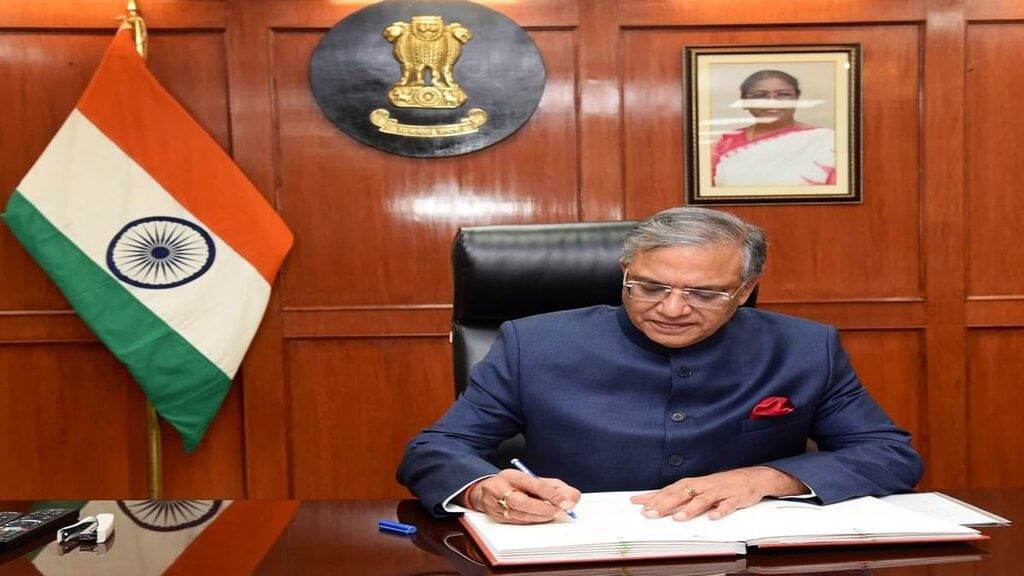UPSC Exam > UPSC Notes > PIB (Press Information Bureau) Summary > PIB Summary - 2nd May, 2025
PIB Summary - 2nd May, 2025 | PIB (Press Information Bureau) Summary - UPSC PDF Download
Three new initiatives by ECI

Election Commission of India: Three Key Reforms for Voter Services
- The Election Commission of India has introduced three important reforms to improve voter services and ensure electoral transparency.
- These reforms include real-time death data integration, redesigned Voter Information Slips, and standardized ID cards for Booth Level Officers (BLOs).
1. Electronic Access to Death Registration Data
- Objective: To enhance the accuracy of electoral rolls by promptly removing deceased voters.
- Mechanism: The Election Commission of India (ECI) will electronically obtain death registration data from the Registrar General of India.
- Legal Backing:
- Rule 9 of the Registration of Electors Rules, 1960
- Section 3(5)(b) of the Registration of Births and Deaths Act, 1969 (amended in 2023)
- Impact:
- Electoral Registration Officers (EROs) will receive real-time death data.
- Booth Level Officers (BLOs) can proactively verify on the ground without the need for Form 7 submissions.
2. Voter Information Slips (VIS) – Enhanced Design
- Objective: To improve voter convenience and clarity regarding polling information.
- Changes Made:
- Prominent display of serial number and part number on the slip.
- Larger font size for easier readability.
- Impact:
- Voters can easily locate their polling stations.
- Improves efficiency for polling officials on election day.
3. Standard Photo Identity Cards for Booth Level Officers (BLOs)
- Objective: To enhance transparency and trust in the voter verification process.
- Directive: All BLOs, appointed under Section 13B(2) of the Representation of the People Act, 1950, will be issued official photo ID cards.
- Impact:
- BLOs will be easily recognizable during field visits.
- Citizens will feel more confident interacting with BLOs during house-to-house verifications.
NHRC, India calls for preventive measures by 11 States to protect the lives of vulnerable people from heat waves in this summer

Context & Current Development
- The National Human Rights Commission (NHRC) has directed 11 heatwave-prone states to implement preemptive and preventive measures to address the increasing mortality risk due to climate-related extremes, as highlighted by NCRB data showing 3,798 deaths from heat and sun strokes between 2018 and 2022.
- This directive is relevant to GS 3 (Disaster Management) and is a response to the alarming rise in deaths caused by extreme heat, emphasizing the need for proactive measures to protect vulnerable populations.
Roots & Institutional Frameworks
- Constitutional Mandate: Article 21 of the Indian Constitution guarantees the right to life and dignity, which includes protection from extreme weather conditions.
- NDMA Guidelines (2016): The National Disaster Management Authority (NDMA) issued guidelines for heat action plans, early warning systems, and protocols for treating heat-related illnesses to mitigate the impact of heatwaves.
- State SOPs: Many states, such as Maharashtra and Odisha, have developed Heat Action Plans (HAPs) as part of their standard operating procedures (SOPs) to address heat-related risks. However, the implementation of these plans varies significantly across states.
- Vulnerability Mapping: There has been a historical neglect in mapping vulnerable groups, including the homeless, outdoor laborers, elderly, children, and slum dwellers, in climate-resilience frameworks. These groups are at higher risk during extreme weather events and require targeted interventions.
Core Concerns Raised by NHRC
- Shelter and Relief Infrastructure: The NHRC highlighted the inadequate shelter and relief infrastructure for economically weaker sections during heatwaves.
- Working Hours: There is a lack of modification in working hours for manual outdoor workers, which increases their vulnerability to heat-related illnesses.
- Hydration and Cooling Support: The dissemination of essential items such as oral rehydration solution (ORS), fans, hydration support, and public cooling spaces is insufficient.
- Public Healthcare Preparedness: Public healthcare systems are not adequately prepared to handle heatstroke cases, which poses a significant risk to affected individuals.
Targeted States
The NHRC's directive targets 11 states that frequently experience intense summer heatwaves, categorized as follows:
- Northern Belt: Punjab, Haryana, Uttar Pradesh, Bihar
- Central & Eastern India: Jharkhand, West Bengal, Odisha
- Deccan & Western India: Andhra Pradesh, Telangana, Maharashtra, Rajasthan
NHRC Recommendations (as per NDMA guidelines)
The NHRC has made several recommendations to the targeted states in line with the NDMA guidelines. These include:
- Immediate Preemptive Measures: Activate cool shelters in schools, anganwadis, and community halls with basic ventilation and water facilities.
- Distribution of Essential Items: Provide ORS, cool roof materials, fans, and other hydration support, particularly in slum colonies and labor camps.
- Alteration of Working Hours: Encourage early morning or late evening shifts for outdoor workers, along with shaded rest areas to reduce heat exposure.
- Medical Preparedness: Train staff at Primary Health Centers (PHCs) and Community Health Centers (CHCs) in the treatment of heat-related illnesses and establish standard treatment protocols.
Implications & Required Actions
1. Public Health & Urban Governance
- Integrate urban health planning with climate risk mapping to ensure preparedness for heatwaves.
- Include heatwave preparedness in the Smart Cities Mission and mandates for urban local bodies to enhance resilience.
2. Labor Rights & Social Protection
- Recognize heatwaves as an occupational hazard under Labour Codes to protect workers' rights.
- Mandate provisions for compensatory breaks, rest shelters, and hydration zones at work sites to safeguard outdoor workers.
3. Disaster Risk Reduction (DRR)
- Mainstream Heat Action Plans (HAPs) as a core component of State Disaster Management Plans (SDMPs) to ensure systematic implementation.
- States should submit Action Taken Reports (ATRs) to the NHRC based on existing Standard Operating Procedures (SOPs) to monitor progress.
4. Welfare for Vulnerable Groups
- Include homeless individuals and the elderly in pre-summer relief planning to ensure they receive necessary support during heatwaves.
- Deploy community workers, Accredited Social Health Activists (ASHAs), and non-governmental organizations (NGOs) to monitor and respond to heat-related issues at the grassroots level.
5. Climate Resilience Policy
- Incorporate urban heat island mitigation strategies, such as cool roofs, green spaces, and reflective surfaces, into climate resilience policies.
- Fund these initiatives through State Climate Action Plans and Climate Resilience Financing Tools to ensure sustainable implementation.
The document PIB Summary - 2nd May, 2025 | PIB (Press Information Bureau) Summary - UPSC is a part of the UPSC Course PIB (Press Information Bureau) Summary.
All you need of UPSC at this link: UPSC
FAQs on PIB Summary - 2nd May, 2025 - PIB (Press Information Bureau) Summary - UPSC
| 1. What are the new initiatives launched by the Election Commission of India (ECI)? |  |
Ans. The new initiatives launched by the Election Commission of India (ECI) focus on enhancing the electoral process and ensuring free and fair elections. Specific details about these initiatives would typically include measures related to voter education, the use of technology in voting, and initiatives aimed at increasing voter turnout.
| 2. What measures is the National Human Rights Commission (NHRC) recommending to protect vulnerable populations from heat waves? |  |
Ans. The National Human Rights Commission (NHRC) is recommending that 11 states implement preventive measures to safeguard vulnerable populations from the severe impacts of heat waves. These measures may include establishing cooling centers, providing access to clean water, and raising public awareness about heat-related health risks.
| 3. Which states are being called upon by the NHRC to take action against heat waves? |  |
Ans. The NHRC has identified 11 states that are particularly vulnerable to the effects of heat waves and has urged them to take necessary actions. The specific states would typically include those with high temperatures and populations at risk, although the exact list may vary based on current climate data.
| 4. Why is it important to protect vulnerable people from heat waves? |  |
Ans. Protecting vulnerable people from heat waves is crucial because extreme heat can lead to serious health issues, including heat exhaustion and heat stroke, and can exacerbate pre-existing health conditions. Vulnerable populations, such as the elderly, children, and those with chronic illnesses, are at a higher risk during heat waves.
| 5. How can individuals help in mitigating the effects of heat waves in their communities? |  |
Ans. Individuals can help mitigate the effects of heat waves by staying informed about weather conditions, checking on vulnerable neighbors, ensuring access to cool spaces, and promoting community awareness about the dangers of heat. Additionally, advocating for local government initiatives to address heat-related health risks can also be beneficial.
Related Searches
















